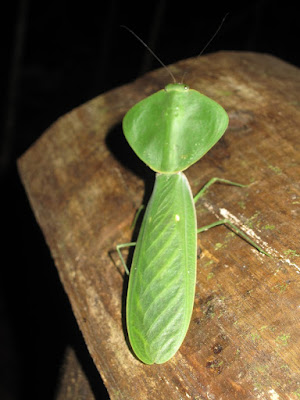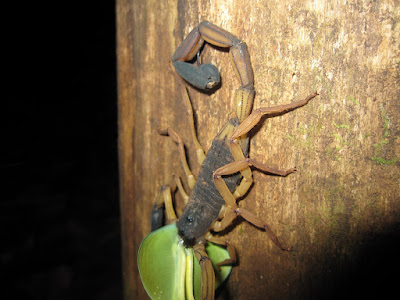Even so, I managed to only got eaten up by mosquitoes the very first night. Simply amazing since I usually am tortured by these creatures and full of welts that last around a week.
We will start off with the Leafcutter ants. On our daily trek from our Cabina at Bosque Del Cabo, there was a couple of ant trails that crossed our path.
Here is what I find to be the highlight of these insects (Compliments of Wikipedia)...
"Leafcutter ants are social insects found in warmer regions of the Americas. These unique ants have evolved an advanced agricultural system based on ant-fungus mutualism. They feed on special structures called gongylidia produced by a specialized fungus that grows only in the underground chambers of the ants' nest."
These beasts were extremely active at night as is represented by the following photo.

And here we have a shot of the them working by day and more detail of the actual insects themselves.

This one took us by total surprise. We had no idea what this was until we got home. At first we thought it was some strange off shoot of the Katydid only to find that this is the infamous Hooded Praying Mantis.
 Equally as green and much larger is the Katydid. One of our crew was brave enough to hold this guy for the camera so we could get perspective on the size.
Equally as green and much larger is the Katydid. One of our crew was brave enough to hold this guy for the camera so we could get perspective on the size.
Here is another one hanging out on the front veranda of the lodge.

One day out at the swimming hole, we encountered this water spider. From toe toe, this spider was about 5-6" long.
Not in the water of course but, apparently it can walk across water as needed.

Susan captured this menacing creature in a palm frond. We believe this is the Golden Orb-Web Spider. Super cool colors and it was about 6 plus inches long!
Most interesting fact we could gather and what this means to you and me...
"The silk of N. clavipes has recently been used to help in mammalian neuronal regeneration. In vitro experiments showed that a single thread of silk can lead a severed neuron through the body to the site it was severed from. With a tensile strength of 4×109 N/m, it exceeds that of steel by a factor of six. It is not recognized by the immune system and has antibacterial properties."
- Sourced from Wikipedia, footnoted to Allmeling et al. 2006

We now turn to our flying friends.
We did see the Blue Morpho butterfly but, we did not have the where-with-all to get a photo. Take note that most of the flying things are quite hard to get good photos of.
Interesting fact about this creature...
"These colors are not a result of pigmentation but are an example of iridescence: the microscopic scales covering the Morpho's wings reflect incident light repeatedly at successive layers, leading to interference effects that depend on both wavelength and angle of incidence/observance."
- Sourced from Wikipedia and footnoted to P. Vukusic, J.R. Sambles, C.r. Lawrence, and R.J. Wootton Quantified interference and diffraction in single Morpho butterfly scales Proc. Roy. Soc. Lond. B 266: 1403-11. (1999)
Here are two shots that seemed noteworthy and we are stepping out on a limb a bit to state that the first is an Owl Butterfly and we have not identified the blue winged one.

As I thnk about it more, this could very well be a juvenile Blue Morpho or maybe just an awesome moth. Not being a trained entimologist has its limitations.

Now for something different (as if). This first insect is extremely cool and was hard to get a good photo of. It kept fidgeting around but, we finally nailed it.
We tried to find out what it was in order to feature it but, to no avail. So I may send this off to an OSU professor to see if he can ID it for us.
 Unidentified bug
Unidentified bug
Remember that game... Centipede! Well this is the real deal.
True Story: The venom from some of these can be life threatening.

Drum roll.....
Scorpion take down!
The first shot is a close up from our previous post. Note this scorpion was about 7" long from claw to tail. I know this seems like a fish tail (per the link of up to 110 mm) but, this sucker was big. The katydid (?) it was eating was no small fry either.

In the close up, you can kinda see that this bug is turning into goo to be sucked up by our flat mate.
Sleep did not come easy with this visitor.

Let it be know that this wicked venomator was much smaller than the one in our Cabina. And see how easily it head butts the rather large Hooded Mantis. Extraordinary wouldn't you agree?


And I leave you with the description from a researcher of being venomated by this night crawler...
"There was immediate pain, as if being penetrated by a thorn much larger than the actual sting. The site of the sting felt tight and as if it was burning, although there was little visible inflimation. [sic] After approximately an hour, the pain had subsided to the point where I was more aware of a sensation of tingling like when you stick your tongue on a 9V Battery. After an additional half hour, the pain and tingling had subsided to the point where my thumb felt like it had a sealed paper cut on it -- where moving my thumb felt odd but keeping it still was without much sensation. Several hours later, this too had subsided and I felt nothing. At no point did I experience any systemic effects, nor did the symptoms extend beyond the initial sting site -- not even as far as my first joint on my thumb."
- Sourced from Wikipedia and footnoted to arachnoboards.com - Arachnoboards > Reports > Sting Reports
No comments:
Post a Comment